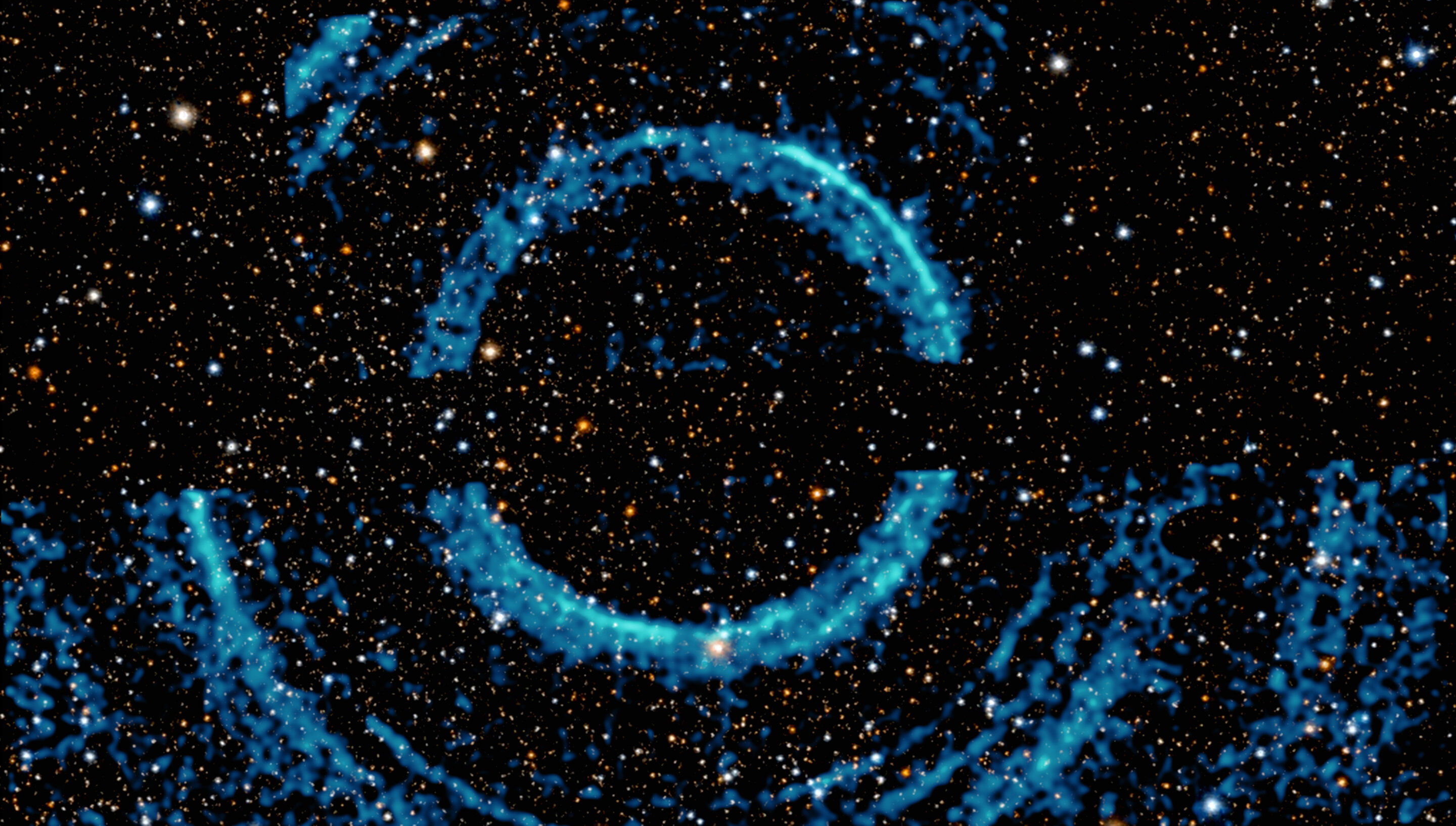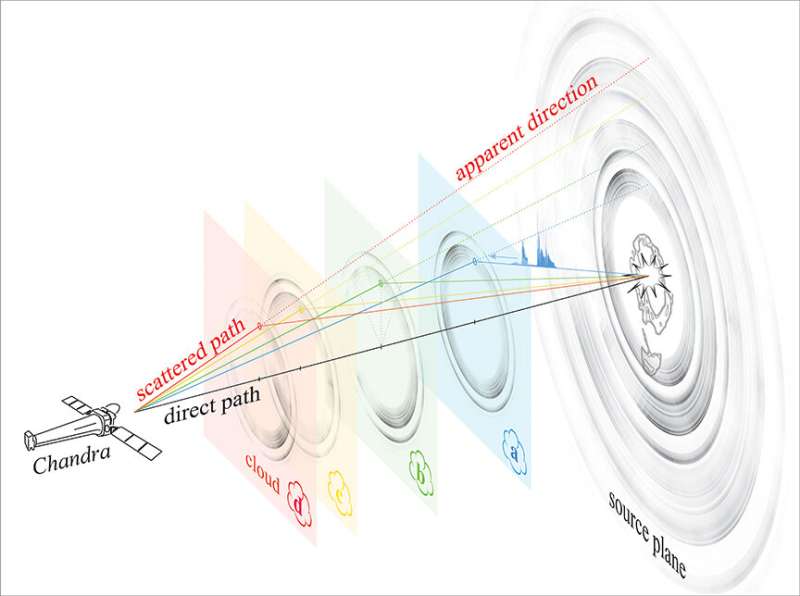Huge ring around a black hole

Credit: X-ray: NASA /
CXC / U.Wisc-Madison / S.Heinz et al.; Optics / IR: PanSTARRS
This image features a magnificent set of rings around a black hole, captured using NASA’s Chandra X-ray Observatory and Neil Gerelswift Observatory. X-ray images of giant rings reveal information about dust in our galaxy, using principles similar to those used in clinics and airports.
Black holes are part of a star system called V404 Cygni at about 7,800. Light year Away from the earth. Black holes are actively attracting matter from a companion star, which weighs about half the mass of the Sun, to a disk around an invisible object. Astronomers call these systems “X-ray binaries” because this material glows with X-rays.
On June 5, 2015, Swift discovered an X-ray burst from the V404 Cygni. Burst created a high-energy ring from a phenomenon known as the light echo.Instead of the sound waves bouncing off the canyon wall, a light echo was generated around the V404 Cygni when a burst of X-rays from the black hole system bounced off. Dust Clouds between V404 Cygni and the Earth. Cosmic dust is not like household dust, it’s like smoke, it’s made up of small solid particles.
In this composite image, X-rays from Chandra (light blue) are combined with optical data from the PanSTARRS telescope in Hawaii, which shows the stars in the field of view. This image contains eight separate concentric rings. Each ring is created by X-rays from the V404 Cygni flare observed in 2015 and reflects off various dust clouds. (The artist’s illustration illustrates how the rings Chandra and Swift saw were created. To simplify the graphic, the illustration shows only four rings instead of eight.
A team of researchers led by Sebastian Heinz of the University of Wisconsin in Madison has conducted 50 Swift observations of the system between June 30 and August 25, 2015 and July 11-25, 2015. We analyzed the Chandra observations made in. Chandra’s operator intentionally placed the V404 Cygni between the detectors so that another bright burst would not damage the equipment.
The ring tells astronomers not only about the behavior of black holes, but also about the landscape between the V404 signi and the Earth. For example, the diameter of an X-ray ring reveals the distance to an intervening cloud of dust that bounces off light. When the clouds are close to the earth, the ring looks big and vice versa. Since the X-ray burst lasted for a relatively short time, the optical echo appears as a narrow ring rather than a wide ring or halo.
Researchers also used rings to examine the properties of the dust cloud itself. They compared the X-ray spectrum (that is, the brightness of X-rays over a range of wavelengths) with computer models of dust of various compositions. Different dust compositions absorb different amounts of low-energy X-rays and are undetectable by Chandra. This is a principle similar to how different parts of our body and luggage absorb different amounts of x-rays and provide information about their structure and composition.
The team determined that the dust was likely to contain a mixture of graphite and silicate particles. In addition, Chandra’s analysis of the inner ring revealed that the density of dust clouds was not uniform in all directions. Previous studies have assumed that this is not the case.

This artist’s illustration details how the ring structure seen by Chandra and Swift is made. Each ring is caused by x-rays bouncing off various dust clouds. If the clouds are close to us, the ring will look big. The result is a set of concentric rings of different apparent sizes, depending on the distance of the intervening clouds from us. Credits: University of Wisconsin-Madison / S.Heinz school
A paper explaining the results of V404 Cygni was published in The Astrophysical Journal (preprint) published on July 1, 2016. The authors of this study are Sebastian Heinz, Lia Corrales (University of Michigan). Randall Smith (Center for Astrophysics | Harvard & Smithsonian); Niel Brandt (Penn State University); Peter Jonker (Netherlands Institute for Space Research); Richard Protokin (University of Nevada, Reno); and Joey Nielson (Villanova University).
This result is related to a similar discovery of the X-ray binary Circinus X-1, which contains neutron stars rather than black holes, in the June 20, 2015 issue of The Astrophysical Journal, “The Lord of the Rings: Kinematic Distance from Giant X-ray Light Echo to Circinus X-1” (preprint). The study was also led by Sebastian Heinz.
Several papers are published annually reporting the study of the 2015 V404 Cygni explosion that caused these rings. Earlier explosions were recorded in 1938, 1956, and 1989, so astronomers could still take years to continue analyzing the 2015 explosion.
S. Heinz et al., V404 Cygni’s 2015 X-ray Dust Scattering Echo Chandra and Swift Joint View, Astrophysical Journal (2016). DOI: 10.3847 / 0004-637X / 825/1/15 , arxiv.org/abs/1605.01648
Provided by
Chandra X-ray Center
Quote: V404 Cygni: https: //phys.org/news/2021-08-v404-cygni-huge-black-hole.html Black hole acquired on August 5, 2021 (August 5, 2021) Huge ring around
This document is subject to copyright. No part may be reproduced without written permission, except for fair transactions for personal investigation or research purposes. The content is provided for informational purposes only.
Huge ring around a black hole
Source link Huge ring around a black hole
No comments:
Post a Comment